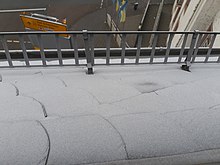Industrial snow
Appearance

Industrial snow occurs near sources of heat, moisture and atmospheric particulate matter. It usually occurs at nighttime, in a combination of freezing temperatures, stagnant low stratus cloud or fog, and a temperature inversion.[1] It falls from a low altitude as fine spikes of ice, having not had time to grow to the more usual shaped snowflake.[2]
It has been observed in Switzerland,[1][3] Germany,[2] Northern Italy (where it is referred to as neve chimica, "chemical snow"),[4] Hungary,[5] in Canada (where it was referred to as refinery snow, or plant snow),[6] the United Kingdom,[7]and Texas.[8]
References
[edit]- ^ a b Liechti, Olivier. "Industrial snow" (PDF). Standing International Road Weather Commission (SIRWEC). Archived from the original (PDF) on 26 February 2018. Retrieved 26 February 2018.
- ^ a b Amberger, Pia (8 December 2016). "Industrial snow: a strange winter phenomenon - Ansbach Hometown Herald". Ansbach Hometown Herald. Retrieved 3 April 2018.
- ^ "'Industrial snow' gives Swiss village very own white Christmas". The Local, ch. The Local Europe AB. 20 December 2016. Retrieved 3 April 2018.
- ^ Giuliacci, Andrea; Di Matteo, Lorenza (2015). Il meteo dalla A alla Z [Meteorology from A to Z] (in Italian). Bari: Dedalo. pp. 86–87. ISBN 9788822068576.
- ^ Dolce, Chris (26 January 2020). "Satellite Images Show Industrial-Effect Snow in Hungary". The Weather Channel. Retrieved 27 January 2020.
- ^ Morin, Margeaux (20 January 2016). "What is refinery snow and how does it cause localized heavy snowfall?". Global News. Corus Entertainment Inc. Retrieved 3 April 2018.
- ^ Julian Mayes. "Linear snowfall trails during freezing fog in southeast England..." Wiley.com. doi:10.1002/wea.4511. Retrieved 20 December 2023.
- ^ "Rare industrial snow event affects the panhandle". NewsChannel 10. Raycom Media. Retrieved 3 April 2018.
